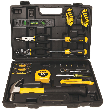Circuit breakers have one purpose and one purpose only: To interrupt electrical currents in your home when there is a sudden surge in the electrical lines. This safety feature is necessary to help protect your wiring, and therefore the costly electrical equipment in your home, like your television or computer. It also helps to prevent fires that could be caused by overheated electrical lines.
Before replacing a circuit breaker you need to determine whether or not the circuit breaker actually needs replacing—it could just be tripped. To check this out, take a look at the breaker box, which is usually located in a basement, laundry room, or utility room. Locate the breaker that is giving you problems. Firmly move the breaker switch towards the off position to reset it, then over to the on position. If it trips again immediately, then you probably have a bad circuit breaker that needs to be replaced.
Write down any identifying information about the problem breaker. If it has a manufacturer's name on it or any numbers, jot them down on a piece of paper and head off to your local hardware or home improvement store. Use the information to find a matching replacement breaker and then take it home. Here's how you then proceed:
If the same breaker trips again, then you have a more serious problem. In such a case, it is a good idea to immediately call an electrician. You might have a short in your wiring, which could be dangerous and cause a fire or other type of damage to your home.

Find the Right Tool Right Away Finally, a homeowner's set that includes all the tools needed to complete basic DIY projects at an affordable price! The tools are stored in a molded case for security and portability. Check out Stanley 65-Piece Homeowner's Tool Kit today!
There are times when you find yourself simply needing another electrical outlet or receptacle more than you currently ...
Discover MoreFor some reason, the bathroom tends to be one of the most overlooked rooms in the home when it comes to interior ...
Discover MoreReplacing an outlet is one of the easier tasks that an amateur electrician can undertake. Here is how you can do this ...
Discover MoreThere are currently no comments for this tip. (Be the first to leave your comment—just use the simple form above!)
Copyright © 2025 Sharon Parq Associates, Inc.
Comments